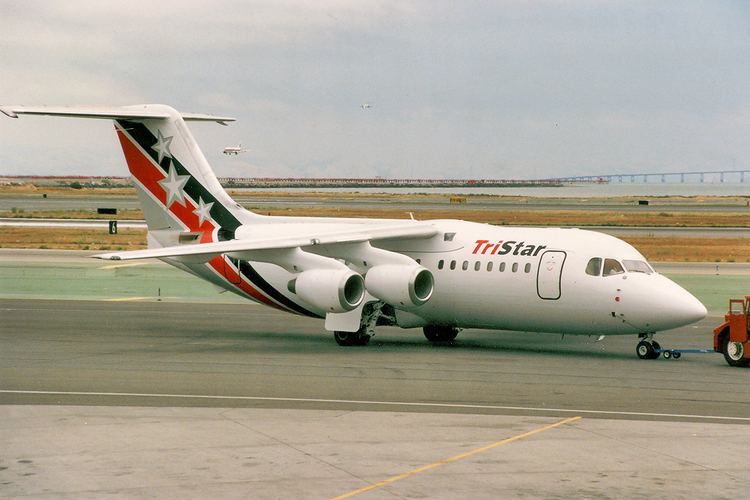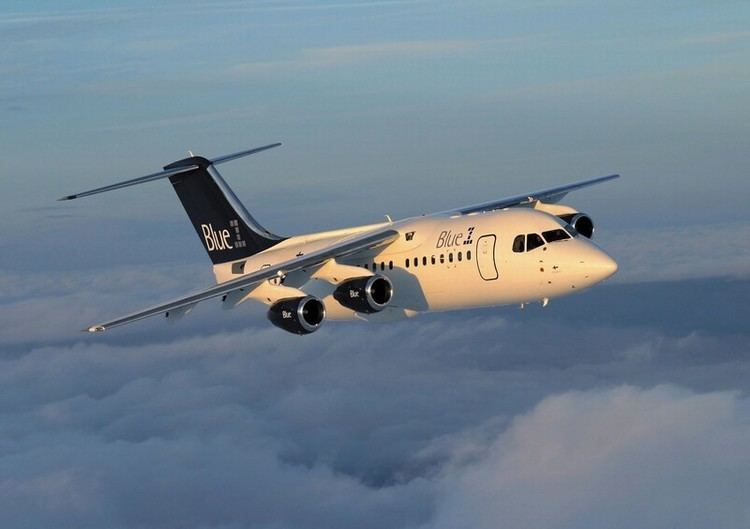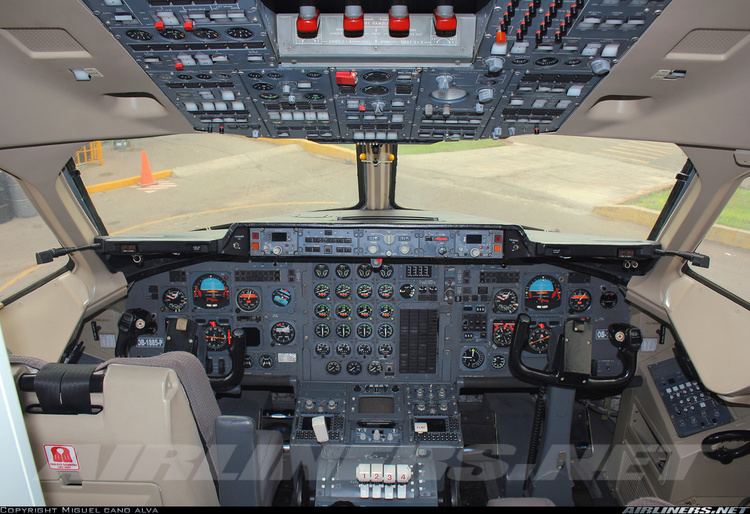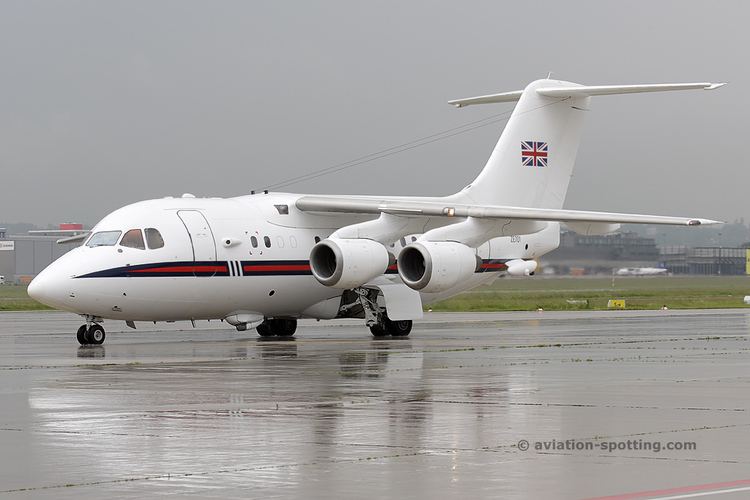Top speed 894 km/h Length 29 m Weight 23,900 kg | Wingspan 26 m Cruise speed 801 km/h Engine type Turbofan | |
 | ||
Manufacturers | ||
British aerospace 146 coming into land warton aerodrome 12 10 15
The British Aerospace 146 (also BAe 146) is a short-haul airliner and a regional airliner that was manufactured in the United Kingdom by British Aerospace, later part of BAE Systems. Production ran from 1983 until 2002. Manufacture of an improved version known as the Avro RJ began in 1992. A further-improved version with new engines, the Avro RJX, was announced in 1997, but only two prototypes and one production aircraft were built before production ceased in 2001. With 387 aircraft produced, the Avro RJ/BAe 146 is the most successful British civil jet airliner programme.
Contents
- British aerospace 146 coming into land warton aerodrome 12 10 15
- G otif bae systems british aerospace 146 200qt take off with atc comms warton aerodrome 29 11 16
- Origins
- Production
- Overview
- Features
- Engines
- Operational history
- BAe 146 100 Avro RJ70 BAe 146 Statesman
- BAe 146 200 and Avro RJ85
- BAe 146 300 Avro RJ100 and RJ115
- BAe 146STA
- BAe 146M
- Avro RJX series
- Firefighter conversions
- Aircraft on display
- Civilian operators
- Military operators
- Former military operators
- Accidents and incidents
- Specifications BAe 146 200
- References

The BAe 146/Avro RJ is a high-wing cantilever monoplane with a T-tail. It has four turbofan engines mounted on pylons underneath the wings, and has retractable tricycle landing gear. The aircraft has very quiet operation, and has been marketed under the name Whisperjet. It sees wide usage at small city-based airports such as London City Airport. In its primary role it serves as a regional jet, short-haul airliner or regional airliner. The BAe 146/Avro RJ is in wide use with several European-based airlines, such as Brussels Airlines, CityJet and Swiss Global Air Lines.

The BAe 146 comes in -100, -200 and -300 models. The equivalent Avro RJ versions are designated RJ70, RJ85, and RJ100. The freight-carrying version carries the designation "QT" (Quiet Trader), and a convertible passenger-or-freight model is designated as "QC" (Quick Change). A "gravel kit" can be fitted to aircraft to enable operations from rough, unprepared airstrips.
G otif bae systems british aerospace 146 200qt take off with atc comms warton aerodrome 29 11 16
Origins

In August 1973, Hawker Siddeley launched a new 70 seat regional airliner project, the HS.146, to fill the gap between turboprop-powered airliners like the Hawker Siddeley HS.748 and the Fokker F.27 and small jet airliners like the BAC One-Eleven and Boeing 737. The chosen configuration had a high wing and a T-tail to give good short-field performance, while the aircraft was to be powered by four 6500 lbf thrust Avco Lycoming ALF 502H turbofan engines. There were several reasons why a twin engine configuration was not chosen. Certainly, a major factor would have been that no manufacturer was producing a 13000 lbf-thrust-class high bypass ratio turbofan engine at the time.

The programme was initially launched with backing from the UK Government, which agreed to contribute 50% of the development costs in return for a share of the revenues from each aircraft sold. In October 1974, all work on the project was halted as a result of the world economic downturn resulting from the 1973 oil crisis.
Low-key development proceeded, however, and in 1978 British Aerospace, Hawker Siddeley's corporate successor, re-launched the project. British Aerospace marketed the aircraft as a quiet, low-consumption turbofan aircraft, which would be effective at replacing the previous generation of turboprop-powered feeder aircraft. The first order for the BAe 146 was placed by Líneas Aéreas Privadas Argentinas in June 1981. Prior to the first flight, British Aerospace had forecast that the smaller 146-100 would significantly outsell the 146-200 variant; however, airlines had showed a great level of interest in the larger 146-200.
By 1981, a large assembly line had been completed at British Aerospace's Hatfield site, and the first completed aircraft flew that year, quickly followed by two more prototypes. Initial flight results showed better-than-predicted takeoff and climb performance. In 1982, British Aerospace stated that the sale of a total 250 aircraft was necessary for the venture to break even. The BAe 146 received its Certificate of Airworthiness on 8 February 1983. Upon its launch into service, it was hailed as being "the world's quietest jetliner".
Production
Early production aircraft were built at Hatfield, which had originally been a de Havilland factory. The Avro RJ family of aircraft was assembled at the Avro International, later BAE Systems Regional Aircraft Centre, at Woodford Aerodrome in Greater Manchester, England. Production of various sections of the aircraft was carried out at different BAE plants. The rear fuselage section was manufactured at BAE Systems' former Avro site at Chadderton, Greater Manchester. The centre fuselage section was manufactured at the Filton BAE site. The vertical stabilizer came from Brough and the engine pylons were made at Prestwick. The nose section was manufactured at Hatfield, where the assembly line for the early aircraft was located. Some manufacturing was subcontracted outside the UK; the wings were made by Textron in the United States and the tailplane and control surfaces were made by Saab-Scania in Sweden.
Due to the sales performance of the BAe 146, British Aerospace announced a development project in early 1991 to produce a new variant of the type, powered by two turbofan engines instead of four, that was offered to airlines as a regional jet aircraft. Dubbed the new regional aircraft (NRA), other proposed alterations from the BAe 146 included the adoption of a new enlarged wing and a lengthened fuselage.
In 1993, the upgraded Avro RJ series superseded the BAe 146. Changes include the replacement of the original Lycoming ALF 502 turbofan engines by higher-thrust LF 507 turbofan engines, which were housed in redesigned nacelles. The Avro RJ series also featured a modernised cockpit with EFIS replacing the analogue ADI, HSI and engine instrumentation. An arrangement between British Aerospace and Khazanah Nasional would have opened an Avro RJ production line in Malaysia; however, this deal collapsed in 1997.
In 2000, British Aerospace announced that it was to replace the Avro RJ series with a further improved Avro RJX series; plans to produce the Avro RJX were officially cancelled in November 2001. Production of the Avro RJ ended with the final four aircraft being delivered in late 2003; a total of 173 Avro RJ aircraft were delivered between 1993 and 2003.
Overview
British Aerospace promoted the BAe 146 to airlines as a "feederliner" and short-haul regional airliner. The airframe of the aircraft and many other key areas were designed to be as simple as possible. The engines lack thrust reversers due to their perceived reduced effectiveness in anticipated conditions. Instead, the BAe 146 features a large airbrake with two petals below the tail rudder at the rear of the fuselage, which has the advantage of being usable during flight and allowing for steep descent rates if required. In addition, the aircraft has full width wing spoilers which are deployed immediately on landing.
The aircraft proved to be useful on "high density" regional and short-haul routes. In economy class, the BAe 146 can either be configured in a standard five-abreast layout or a high-density six-abreast layout, making it one of very few regional jets that can use a six-abreast layout in economy class. Reportedly, the aircraft is profitable on most routes with only marginally more than half the seats occupied.
The BAe 146 is also renowned for its relatively quiet operation, a positive feature that appealed to those operators that wanted to provide services to noise-sensitive airports within cities. The aircraft is one of only a few types that can be used on flights to London City Airport, which has a steep approach and short runway; for several years the BAe 146 was the only conventional jet aircraft capable of flying from London City Airport.
Features
According to the BAe 146's chief designer, Bob Grigg, making the aircraft as easy to maintain as possible and keeping operators' running costs as low as possible were considered high priorities from the start of the design process. Grigg highlighted factors such as design simplicity, using off-the-shelf components where possible, and the internal use of firm cost targets and continuous monitoring. British Aerospace also adopted a system of cost guarantees between component suppliers and the operators of the BAe 146 in order to enforce stringent requirements.
Drawing on experience from the Hawker Siddeley Trident and the Airbus A300, both the fuselage and wing were carefully designed for a reduced part count and complexity. A high-mounted wing was adopted with an uninterrupted top surface; the BAe 146's wing did not make use of leading-edge extensions, which also enabled a simplified fixed tailplane. The undercarriage of the aircraft is toughened to resist damage and stability is maximised by the placement of landing gear, of particular value when operating from rough airstrips.
The BAe 146 was the second aircraft, after the Concorde, to use carbon brakes. The aircraft features a low amount of composite material, used in parts of the secondary structure only. Initial production aircraft featured a conventional cockpit and manual flight controls. At launch, the onboard auxiliary power unit (APU) consumed only half the fuel and weighed only a third as much as other contemporary models.
Engines
The BAe 146 is powered by four Avco Lycoming ALF 502 turbofan engines, which are fixed on pylons underneath the aircraft's high wing. The ALF 502 was derived from the Lycoming T55 turboshaft powerplant that powers the Chinook heavy transport helicopter. Notably, the ALF 502 had a very low level of operational noise, much lower than most other competing aircraft. This was achieved partly by the engine's high bypass ratio along with additional sound damping layers built into the engine.
Early on, the decision to adopt four engines for a feeder airliner rather than two was viewed as atypical by some commentators. Advantages of adopting the four engine configuration include greater redundancy and superior takeoff performance from short runways, as well as in hot and high conditions. Electrical power is primarily provided by generators located on each of the outboard engines. For ease of maintenance and reduced operator costs, the ALF 502 is of a modular design and makes minimum use of specialist tooling.
The ALF 502 has experienced multiple issues. Its internal electronics could overheat, triggering an automatic shutdown of an engine with no option for inflight restart, and certain rare atmospheric conditions could cause a loss of engine thrust due to internal icing. Additionally, the BAe 146 experienced some issues with its bleed air and cabin pressurization systems, leading to a number of fume events where irritant fumes were introduced into the cabin via the pressurizing system.
Operational history
In May 1983, British airline Dan-Air became the first carrier to launch services using British Aerospace's new 146; the first revenue-earning service was flown between London Gatwick Airport and Berne Airport. On 1 July 1984, the first of 20 BAe 146s ordered by Pacific Southwest Airlines was officially delivered. Air Wisconsin was another major US operator of the 146, replacing their fleet of turboprop Fokker F27 Friendships with the type. In 1985, Aspen Airways inaugurated the first scheduled jet service into Aspen, Colorado in the Rocky Mountains of the western U.S. with a BAe 146-100 operating from an airfield with an elevation of 7,820 feet. It was announced in January 1987 that the BAe 146 had been selected to launch the first jet services from London City Airport; it was chosen due to its unmatched flying characteristics and ability to operate from so-called STOLports.
The 146 was introduced into Royal Air Force service in 1986 as a VIP transport; it was the first jet aircraft to be operated by 32 (The Royal) Squadron. According to Flight International, at least 25 executive aircraft have been produced for various customers, many of these had undergone conversions following airline operations.
The type was widely used for passenger services in Australia from the late 1980s until the early 2000s, where the aircraft was suited for long-distance, low-volume routes. 18 were in service with Ansett Australia in 1999. The BAe 146 was also operated by East-West, taking delivery of eight from 1990, until the company was absorbed into Ansett. Cobham Aviation Services Australia began operations under the Airlink brand on behalf of Australian Airlines (and later Qantas) in 1990 using the type until 2005. As of 2012, Cobham continue to operate 15 BAe 146 and Avro RJ variants for scheduled cargo and passenger charter operations, including the second production airframe, a -100 model converted to QT specification which first flew in January 1982 as part of the testing and certification program.
The initial customer for the BAe RJ85 series was Crossair, who took delivery of their first aircraft on 23 April 1993.
Several major cargo operators have operated the type. As of 2012, the BAe 146 QT is the most numerous aircraft in TNT Airways's air freighter fleet. In 2012, it was announced that the RAF would acquire the BAe 146M as an interim transport aircraft between the retirement of the Lockheed C-130 Hercules and the introduction of the larger Airbus A400M Atlas.
BAe 146-100, Avro RJ70 & BAe 146 Statesman
First flight of the -100 occurred on 3 September 1981, with deliveries commencing in 1983. The launch customer in March 1983 was Dan-Air. From 1986, The Queen's Flight of the RAF acquired a total of three 146-100s, designated BAe 146 CC2. These aircraft were fitted with a luxurious bespoke interior and operated in a VIP configuration with a capacity of 19 passengers and six crew. The BAe 146-100QC is the convertible passenger/freight version and the BAe 146-100QT (Quiet Trader) is the freighter version.
The -100 was the last of the 146 series designs to be developed into the Avro RJ standard with first deliveries of the Avro RJ70 in late 1993. The RJ70 differed from the 146-100 in having LF 507 engines with FADEC and digital avionics. The RJ70 seats 70 passengers five abreast, 82 six abreast or 94 in high-density configuration.
BAe 146-200 and Avro RJ85
The 146-200 features a 2.41 m (7 ft 11 in) fuselage extension and reduced cost per seat mile. The -200 first flew in August 1982 and entered service six months later. The BAe 146-200QC is the convertible passenger/freight version and the BAe 146-200QT (Quiet Trader) is the freighter version. Two BAe 146-200QC aircraft, designated BAe 146 C3 were converted for the RAF, with infrared countermeasures systems and flare dispensers, for use in Afghanistan.
The Avro RJ85, the first RJ development of the BAe 146 family, features an improved cabin and the more efficient LF 507 engines. Deliveries of the RJ85 began in April 1993. The RJ85 seats up to 112 passengers.
BAe 146-300, Avro RJ100, and RJ115
British Aerospace announced its initial proposals for the -300 at the 1984 Farnborough Air Show. The aircraft's fuselage was to be stretched by 3.2 metres (10 ft 6 in) compared with the -200, allowing 122 passengers to be carried at 32-inch seat pitch and 134 at 29-inch seat pitch. More powerful (33 kilonewtons (7,500 lbf)) ALF 502R-7 engines would be used, and winglets were to be fitted to the aircraft's wingtips. However, due to airlines favouring a lower initial price rather than minimising seat-mile costs, the definitive 146-300 emerged as a less extreme development. The fuselage was stretched by 2.34 metres (7 ft 8 in) m stretch of the -200, giving a capacity of 100 passengers seated 5-abreast at 31-inch seat pitch, without winglets or the proposed ALF 502R-7. Deliveries began in December 1988. A modified BAe 146-301 is used as the UK's Facility for Airborne Atmospheric Measurements (FAAM). The BAe 146-300QC is the convertible passenger/freight version and the BAe 146-300QT (Quiet Trader) is the freighter version.
The Avro RJ version of the 146-300, the second such development of the 146 product line, became the Avro RJ100. It shared the fuselage of the 146 version, but with interior, engine and avionics improvements. The most common configuration in the RJ100 seats 100 passengers. An RJ115 variant, the same physical size but with an increased MTOW and different emergency exits, was marketed but never entered production; it sat 116 as standard or up to a maximum of 128 in a high-density layout.
BAe 146STA
Throughout the production life of the BAe 146, British Aerospace proposed a number of specialised military versions, including side- and rear-loading transports, an airborne tanker version, and a carrier onboard delivery version. Out of these proposals came the BAe 146STA (Sideloading Tactical Airlifter), based on the BAe 146QT cargo aircraft and sharing its cargo door on the left side of the rear fuselage. This military transport version has a refuelling probe protruding from the nose; a demonstrator, fitted with a dummy refuelling probe and an air-openable paratroop door was displayed at the 1989 Paris Air Show and carried out extensive demonstration tours, but no orders resulted.
BAe 146M
BAE Systems announced the BAe 146M programme in 2009, designed to provide ex-civilian BAe 146-200 and -300 aircraft to military operators, available either in passenger or freighter configurations. Upgrades and alterations made to the type include new glass cockpit avionics, additional fuel tanks, increased steep approach and unpaved runway operation capabilities, and being outfitted with defensive aids; however a rear cargo door was not introduced. BAE has stated that the 146M is suitable for performing airlift, medical evacuation, para-drop, surveillance, or inflight refueling operations.
Avro RJX series
The RJX-70, RJX-85 and RJX-100 variants represented advanced versions of the Avro RJ Series. The RJX series used Honeywell AS977 turbofans for greater efficiency (15% less fuel-burn, 17% increased range), quieter performance and 20% lower maintenance costs. Bhutan carrier Drukair ordered two RJX-85s, while British European placed firm orders for 12 RJX-100s and eight options. However, BAE Systems terminated the project in December 2001, having completed and flown only three aircraft—a prototype each of the RJX-85 and RJX-100, and a production RJX-100 for British European. BAE reached an agreement with Druk Air and British European in early 2002 in which the airlines agreed not to enforce their firm orders for the RJX. BAE explored the possibility of manufacturing 14 "hybrid" aircraft, however British European at least was unwilling to accept the risk of operating a unique type.
Firefighter conversions
Firefighting air tanker versions of both the BAe 146 and the Avro RJ85 have been manufactured via the conversion of aircraft previously operated by airlines. Several organisations carry out such conversions, including U.S.-based Minden Air Corporation, Neptune Aviation Services, and Aero Flite. In January 2012, Conair Group announced its arrangements to market and promote the Avro RJ85 as a major air tanker platform. In October 2012, Air Spray Aviation of Alberta, Canada purchased its first BAe 146 for conversion into an air tanker. Air Spray purchased a second airframe for conversion in October 2013.
Aircraft on display
Civilian operators
As of February 2017 a total of 57 BAe 146 aircraft (all variants) remain in airline service. Major operators include:
Air Wisconsin (United Express), Pacific Southwest PSA, Presidential Air.
As of June 2016, a total of 102 Avro RJ aircraft (all variants) also remain in airline service. Major operators include:
Military operators
Former military operators
Accidents and incidents
The BAe-146/Avro RJ has been involved in 13 hull-loss accidents with a total of 223 fatalities and one criminal occurrence with 43 fatalities.
Specifications (BAe 146-200)
Data from Jane's All The World's Aircraft 1993–94
General characteristics
Performance
